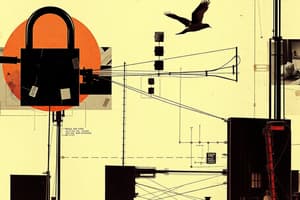Podcast
Questions and Answers
What is the concern if incoming packets arrive at Telnet, FTP, SUNRPC, or IMAP ports when they are not used by the site?
What is the concern if incoming packets arrive at Telnet, FTP, SUNRPC, or IMAP ports when they are not used by the site?
- The network is being scanned for vulnerabilities
- The site may be under a DDoS attack
- The incoming packets are suspicious (correct)
- The firewall rules need to be updated
What type of signature is the WinNuke attack an example of?
What type of signature is the WinNuke attack an example of?
- Signature-based detection
- Header signature (correct)
- Protocol anomaly detection
- Anomaly-based detection
What is the purpose of placing a NIDS sensor outside the main enterprise firewall?
What is the purpose of placing a NIDS sensor outside the main enterprise firewall?
- To monitor internal network traffic
- To filter out unwanted traffic
- To analyze network protocol usage
- To establish the level of threat for a given enterprise network (correct)
What is the significance of a TCP packet with both SYN and FIN flags set?
What is the significance of a TCP packet with both SYN and FIN flags set?
What is the purpose of a NIDS sensor in the DMZ?
What is the purpose of a NIDS sensor in the DMZ?
What is the primary goal of NIDS sensor placement?
What is the primary goal of NIDS sensor placement?
What type of detection is useful for identifying unknown attacks?
What type of detection is useful for identifying unknown attacks?
What is the primary advantage of placing a NIDS sensor inside the main firewall but outside internal firewalls?
What is the primary advantage of placing a NIDS sensor inside the main firewall but outside internal firewalls?
What is the significance of a NIDS sensor in identifying the source of an attack?
What is the significance of a NIDS sensor in identifying the source of an attack?
What is the primary goal of analyzing firewall logs?
What is the primary goal of analyzing firewall logs?
Study Notes
NIDS Placement
- NIDS sensors can be placed behind internal firewalls to monitor major backbone networks, LANs, and specific network segments for more targeted attacks.
- Four types of locations for NIDS sensors:
- Outside the main enterprise firewall: monitors threat levels and helps win management support for security efforts.
- In the network demilitarized zone (DMZ), inside the main firewall but outside internal firewalls: monitors penetration attempts on open services.
- Behind internal firewalls: monitors major backbone networks and LANs.
- Behind internal firewalls: monitors LANs that support user workstations and servers specific to single departments.
Firewalls
- A firewall is a barrier between two computers or computer systems.
- Firewalls filter incoming packets based on parameters like packet size, source IP address, protocol, and destination port.
- Linux and Windows (from XP onwards) have built-in firewalls.
- Windows 7 expanded firewall functionality to handle inbound and outbound traffic filtering.
- Windows 8 and 10 did not change firewall functionality significantly.
- Individual computer firewalls should be turned on and configured in addition to perimeter firewalls.
- Dedicated firewalls are necessary between a network and the outside world in an organizational setting.
NIDS Function
- Network-based IDS monitors network traffic on a specific segment as a data source.
- NIDS captures all network traffic by placing the network interface card in promiscuous mode.
- Three primary types of signatures:
- String signatures: look for specific text strings indicating possible attacks (e.g., UNIX “cat “+ +” >/.rhosts”).
- Port signatures: watch for connection attempts to frequently attacked ports (e.g., Telnet TCP port 23, FTP TCP port 21/20).
- Header signatures: detect dangerous or illogical packet header combinations (e.g., WinNuke, TCP packet with both SYN and FIN flags set).
Studying That Suits You
Use AI to generate personalized quizzes and flashcards to suit your learning preferences.
Description
This quiz deals with the placement of Network Intrusion Detection Systems (NIDS) and firewalls in a network. It covers the locations and benefits of monitoring backbone networks and LANs.




